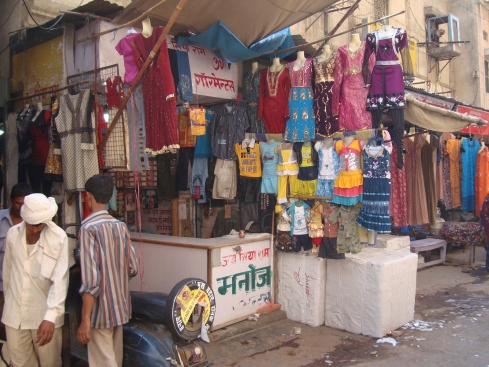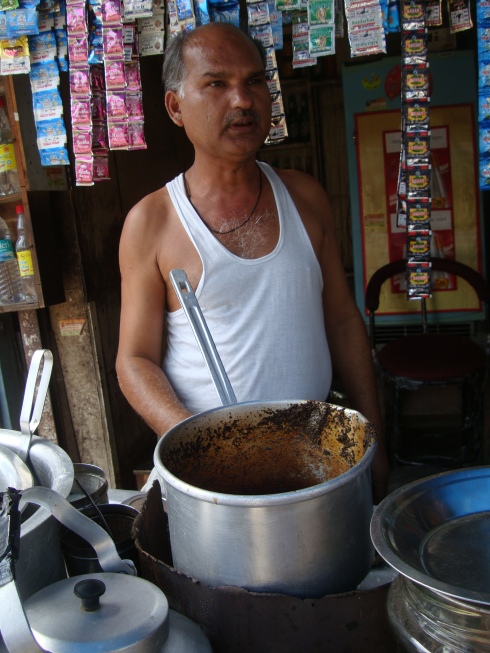It was a typical Wednesday at the office and I still had a few days of work before my weekend trip to Chandigarh. Around lunch time someone walked into the office and very calmly said: “Turn off your computers and come downstairs. The building is on fire.”
After exchanging looks of confusion, colleagues and I slowly followed the instructions. Within 5 minutes after exiting the building, the first floor was being voraciously consumed by flames.
Half an hour after, the fire-fighters finally arrived. My administration suggested that we all go out for lunch since there wasn’t much we could do anyway.
Although the restaurant personnel did not expect a party of thirty to walk in without a reservation, they managed quite well and my Thali tasted superb. The only issue I had with the meal was my dessert. As delicious as an icy, chocolate concoction should taste in 40 degrees weather, mine wasn’t the case. As I felt something solid in my mouth, I figured it was just a piece of ice, which I am used to finding in Indian ice creams. Usually I just eat the ice, but this time I thought it was a bit too big. When I took it out on the spoon, I shouted in horror while the waiter who happened to stand beside me at that particular moment ran for the manager. A huge screw sat in front of me. I laughed. The entire party was reimbursed.
After the incident, our dear administration suggested that due to fire, we may have to work from home for the next couple of days. The moment I heard that, I knew immediately that there is no way I am waiting until the weekend to travel to Chandigarh.
I went home and booked my ticket to go right that night. The ticket was waitlisted for eight people, meaning that unless 8 people cancel their rides in the next 5 hours, my ticket would be reimbursed automatically and I am not going anywhere.
By the time it was 2 hours before departure, the wait list went down to 5. Chances of me going anywhere were in the negative . I took a taxi to the Old Delhi train station thinking: “What do I have to lose?”
On the platform I panicked that my name was not on the chart, suggesting that my ticket was in fact cancelled, and it is illegal for me to board. In pure desperation, I turned to a man standing beside me and explained my situation. “I ordered a ticket and it is waitlisted, but I absolutely must get on this train. What do I do?”
The man was well dressed and spoke good English. He held two cell phones in one hand and a printout of his ticket for the same train in the other. Later I found out that his name was Sunni. After he skimmed through the charts, unable to find my name, he went to the train attendant.
Responsibilities of the train attendant include collecting money, checking tickets, and assuring order in a particular train car. After Sunni presented my case to him in Hindi, the attendant and a few other men standing beside him started snickering and looking at me funny. I was a woman, I was alone, and I was white.
“They are asking me why I am helping you,” said Sunni. “They think I have bad intentions, but don’t worry, I don’t’ have any intentions.”
“Okay,” I said warily. “Can I get on the train?”
“Hold on,” replied Sunni and launched into a further conversation with the train attendant.
Ten minutes later Sunni explained to me that I can get on the train, but I will have to pay a fine.
“Thank God!” I exclaimed. After, I found out that the fine and the ticket together will cost me about 14 Canadian dollars for an air conditioned 8 hour train ride, which clearly was absolutley cool with me.
“Yes, but there are no empty seats on the train, so you can’t really get on,” said Sunni.
“Okay, so what do I do then?” I asked disappointed.
“I don’t know…You cannot get on the train,” Sunni replied apologetically.
“Boo!” I thought to myself. “First they give me hope and then they take it away”
“Well, you can share a seat with me if you want,” offered Sunni.
My jaw almost dropped in surprise.
“Are you serious? You wouldn’t mind?” I exclaimed. “Thank you so much! I’ll pay for your ticket!”
“No no, it’s okay. Don’t thank me. Thank God and let’s get on!”
And just like that Sunni saved the day. Later it turned out that one passenger did not show up, and I had my own bed. I couldnt believe my luck.
Sunni and I chatted for a while and I found out that he had applied to immigrate to Vancouver three times. He was rejected twice, but this time he’s hoping to get a different answer.
I thanked him at least a million times.
“Stop thanking me! Thank God,” he replied every time.
Everything was really great until he started showing me pictures of his family. After I saw pictures of his wife and kids, he played a video in which a young Indian woman was behaving rather coquettishly. She was dressed, but somehow I knew she wasn’t going to stay that way for too long.
“Thank you, but I don’t think I want to watch this!” I said to Sunni and turned away.
“What’s with the Indian men trying to always show porn or rape scenes to white girls??” I asked myself. “This is not the first time this is happening.”
“She is my friend’s wife and she wanted him to videotape her. It was her own will, no one forced her,” explained Sunni.
“Hmm, I see,” I said indifferently still facing away.
“You don’t want to watch?” he inquired.
“No, thank you,” I said politely, thinking how ridiculous this situation was.
I was very happy to have the upper berth for sleeping, because on the lower one the chance of being robbed or touched is much greater. I made my bed and proceeded to go to sleep. Sunni attempted to show me the video one more time and I again declined the offer. First, I was scared to fall asleep, but there was another man and his wife in the same train compartment, so I figured it was safe enough to catch some zzzs.
At 7am I arrived to Anandpur Sahib, the home of the second holiest Sikh temple in India after the Golden Temple. I love the Sikhs for their kindness, acceptance, and of course the turbans they wrap so skilfully around their heads. Anyone can come to a Sikh temple and have a free meal at any time of the day. The dishes are then washed collectively by all attendees. Worshipers are also welcome to stay at the temple for several nights. No money is to be paid, but donations are appreciated.
I walked around the temple for several hours, ate, and washed dishes. Later I called my friend, Ishaan, who I was going to stay with in Chandigarh, and told him that I am catching a bus and will be in the city in 2 hours.
Three and a half hours later, a non air-conditioned bus full of men only, dropped us off in the middle of nowhere. Everyone who was going to Chandigarh was to get into an 8-seater mini bus. Of course, the number of seats did not match the number of travellers. We were at least 25. I was told to sit in the front, most likely because I was white and I was the only woman at that point. Later, another woman and her child shared the one front seat with me. It was tight, but I felt relieved to see another female. The window pane of the mini bus looked like a bullet went through it not too long ago. “It’s going to be okay, it’s going to be okay,” I kept telling myself.
And it was. Half an hour later I finally made it to the Florida-like place called Chandigarh. While Ishaan and I were driving to meet his family, I wondered how Indians go through similar adventures every day, and thanked whatever higher power for letting me reach Chandigarh in one piece.
























